For our tour description, itinerary,
past triplists, dates, fees, and more, please VISIT OUR TOUR PAGE.
See this triplist in printable PDF format with media only on
page 1.
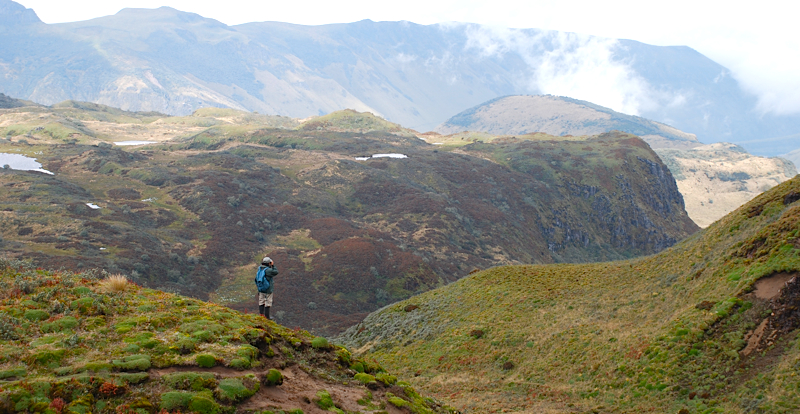
Dwarfed by the
magnificent montane scenery, guide Willy Perez scours the
paramo in search of Rufous-bellied Seedsnipe. (Photo by tour
participants Bob Sprague and Amy Levengood)
We had yet another sensational Jewels of Ecuador trip; we
could not have had a more gung-ho and fun group, the weather
really worked to our advantage - sure, we got some rain, but
this is Ecuador! - and the birds just kept coming, wave after
wave! It was also a personal thrill for me to lead a trip with
William Perez with him on board as an official Field Guides's
leader... what a rich amount of information, skillful
leadership, and natural humor he brought to the table. We were
also fortunate to have had such a skilled and careful driver
in Edgar... three cheers for both William and Edgar!!!
Ecuador is a country of immense beauty, packed into an area
about the size of Colorado, but stacked high with diversity
like a twenty-layer sandwich, with all of the fixings! Sound
intimidating... well it is! Just think back to all of the
habitats and forest types we birded that hold entirely
different sets of birds. We started in the high, stunted
temperate and orchid-laden forests at Yanacocha, birded the
following day in the mountainous deciduous thorn forests of
the Catamayo Valley, hit the montane and foothill forests out
of Loja and Zamora, respectively, and got a taste of the
intermontane temperate habitats - a very endangered forest
type - north of Loja on our way to Cuenca. We then had a
beautiful weather day birding our first high, windswept
paramos at Cajas National Park, then flew north for another
eight full days of birding the the east and west slopes out of
Quito, where we got tastes of many humid Andean habitats,
including rich subtropical and foothill forests out of San
Isidro (some very much Amazonian-influenced) and the endemic
rich Choco biome based out of Mindo.
With 16 full days of birding, this is a "longish" tour. We
have designed it to hit some of the most bird-rich spots in
the Ecuadorian Andes in both the north and south, hitting just
about all of the major habitat zones in the country, minus the
coast and lower Amazon. The result: a huge species list that
usually tops out over 600; that is averaging somewhere around
40 new birds a day! But what was even more important, and so
obviously appreciated by this keen group, were the quality
looks that we repeatedly had at our quarry, many of them rare
and range-restricted. Take as an example the Tanager Finch, a
very local bird of mid-elevation ridges of the west slope that
most birders try hard to see, but often miss (happens to me
all of the time!); we had in-your-face studies at pair within
only minutes of trying, that left us shocked. Another one that
comes to mind is the Peruvian Antpitta, a bird so rare that it
wasn't even known well in life until its nest was found at San
Isidro. Well, we had one come to a worm feeder at San Isidro
after only a few minutes of waiting, binoculars poised on the
spot... magic! And these cases weren't the exception, but
rather the norm! The good looks at birds, rare and common,
flooded our binoculars daily.
Some other goodies that deserve honorable mention and that
really made this a superb birding trip include Fasciated
Tiger-Heron grabbing fish with incredible skill; stunning
views at a small group of the rare and endangered Red-faced
Parrot; unbeatable Band-bellied Owl at Copalinga; an amazingly
long-tailed Lyre-tailed Nightjar on a day roost; an impressive
display of foraging Oilbirds at San Isidro; more hummingbirds
than we will ever be able to digest (!); some impressive
toucans, but how about those Plate-billed Mountain-Toucans at
fruit feeders; up close views of Ocellated Tapaculos;
Orange-breasted and Scaled fruiteaters in the west;
Club-winged Manakins at a lek; a couple of really nice
Beautiful Jays near Tandayapa; awesome White-capped Tanagers
at San Isidro; fantastic Giant Conebills in the high
paramos... I could just go on and on, but that would defeat
the purpose of the list that follows, so read on!
Thanks for joining Willy and I and helping to make this a fun
and rewarding trip! We both look forward to seeing you all on
another trip sometime soon!
--Mitch
KEYS FOR THIS LIST
One of the following keys may be shown in brackets for
individual species as appropriate: * = heard only, I =
introduced, E = endemic, N = nesting, a = austral migrant, b =
boreal migrant
Tinamidae (Tinamous)
TAWNY-BREASTED TINAMOU (Nothocercus julius) [*]
LITTLE TINAMOU
(Crypturellus soui)
Anatidae (Ducks, Geese, and Waterfowl)
TORRENT DUCK (Merganetta armata)
YELLOW-BILLED
PINTAIL (Anas georgica)
ANDEAN TEAL
(Anas andium)
RUDDY DUCK
(ANDEAN) (Oxyura jamaicensis
ferruginea)
Cracidae (Guans, Chachalacas, and
Curassows)
SPECKLED CHACHALACA (Ortalis guttata)
BEARDED GUAN
(Penelope barbata)
ANDEAN GUAN
(Penelope montagnii)
WATTLED GUAN
(Aburria aburri)
SICKLE-WINGED GUAN
(Chamaepetes goudotii)
Odontophoridae (New World Quail)
RUFOUS-FRONTED WOOD-QUAIL (Odontophorus erythrops) [*]
DARK-BACKED
WOOD-QUAIL (Odontophorus
melanonotus)
RUFOUS-BREASTED
WOOD-QUAIL (Odontophorus
speciosus) [*]
Phalacrocoracidae (Cormorants and Shags)
NEOTROPIC CORMORANT (Phalacrocorax brasilianus)
Ardeidae (Herons, Egrets, and Bitterns)
FASCIATED TIGER-HERON (Tigrisoma fasciatum)
GREAT EGRET
(Ardea alba)
SNOWY EGRET
(Egretta thula)
CATTLE EGRET
(Bubulcus ibis)
Cathartidae (New World Vultures)
BLACK VULTURE (Coragyps atratus)
TURKEY VULTURE
(Cathartes aura)
ANDEAN CONDOR
(Vultur gryphus)
Pandionidae (Osprey)
OSPREY (Pandion
haliaetus)
Accipitridae (Hawks, Eagles, and Kites)
HOOK-BILLED KITE (Chondrohierax uncinatus)
SWALLOW-TAILED
KITE (Elanoides forficatus)
BLACK-CHESTED
BUZZARD-EAGLE (Geranoaetus
melanoleucus australis)
SHARP-SHINNED HAWK
(PLAIN-BREASTED) (Accipiter
striatus ventralis)
BARRED HAWK
(Leucopternis princeps)
SEMIPLUMBEOUS HAWK
(Leucopternis semiplumbeus)
ROADSIDE HAWK
(Buteo magnirostris)
BROAD-WINGED HAWK
(Buteo platypterus)
[b]
WHITE-RUMPED HAWK
(Buteo leucorrhous)
SHORT-TAILED HAWK
(Buteo brachyurus)
VARIABLE HAWK
(Buteo polyosoma)
Falconidae (Falcons and Caracaras)
BARRED FOREST-FALCON (Micrastur ruficollis)
COLLARED
FOREST-FALCON (Micrastur
semitorquatus) [*]
BLACK CARACARA
(Daptrius ater) [*]
CARUNCULATED
CARACARA (Phalcoboenus
carunculatus)
LAUGHING FALCON
(Herpetotheres cachinnans)
AMERICAN KESTREL
(Falco sparverius)
APLOMADO FALCON
(Falco femoralis)
Rallidae (Rails, Gallinules, and Coots)
PLUMBEOUS RAIL (Pardirallus sanguinolentus)
Charadriidae (Plovers and Lapwings)
SOUTHERN LAPWING (Vanellus chilensis)
ANDEAN LAPWING
(Vanellus resplendens)
Scolopacidae (Sandpipers and Allies)
SPOTTED SANDPIPER (Actitis macularius) [b]
Thinocoridae (Seedsnipes)
RUFOUS-BELLIED SEEDSNIPE (Attagis gayi)
Laridae (Gulls, Terns, and Skimmers)
ANDEAN GULL (Chroicocephalus serranus)
Columbidae (Pigeons and Doves)
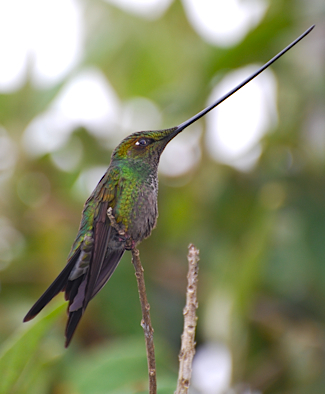
Arguably one of
the most spectacular of the 70+ hummingbird species seen
on the tour- the aptly-named Sword-billed Hummingbird.
(Photo by tour participants Bob Sprague and Amy Levengood)
ROCK PIGEON (Columba livia) [I]
BAND-TAILED PIGEON
(Patagioenas fasciata)
PLUMBEOUS PIGEON
(Patagioenas plumbea)
RUDDY PIGEON
(Patagioenas subvinacea)
DUSKY PIGEON
(Patagioenas goodsoni)
EARED DOVE
(Zenaida auriculata)
CROAKING
GROUND-DOVE (Columbina
cruziana)
WHITE-TIPPED DOVE
(Leptotila verreauxi)
PALLID DOVE
(Leptotila pallida)
GRAY-FRONTED DOVE
(Leptotila rufaxilla)
WHITE-THROATED
QUAIL-DOVE (Geotrygon frenata)
Psittacidae (Parrots)
MAROON-TAILED PARAKEET (Pyrrhura melanura)
WHITE-NECKED
PARAKEET (Pyrrhura albipectus)
BARRED PARAKEET
(Bolborhynchus lineola)
PACIFIC PARROTLET
(Forpus coelestis)
RED-FACED PARROT
(Hapalopsittaca pyrrhops)
BLUE-HEADED PARROT
(Pionus menstruus)
RED-BILLED PARROT
(Pionus sordidus)
SPECKLE-FACED
PARROT (WHITE-CAPPED) (Pionus
tumultuosus seniloides)
BRONZE-WINGED
PARROT (Pionus chalcopterus)
SCALY-NAPED PARROT
(Amazona mercenaria)
MEALY PARROT
(Amazona farinosa)
Cuculidae (Cuckoos)
SQUIRREL CUCKOO (Piaya cayana)
STRIPED CUCKOO
(Tapera naevia)
SMOOTH-BILLED ANI
(Crotophaga ani)
GROOVE-BILLED ANI
(Crotophaga sulcirostris)
Strigidae (Owls)
COLOMBIAN SCREECH-OWL (Megascops colombianus) [*]
WHITE-THROATED
SCREECH-OWL (Megascops
albogularis)
BAND-BELLIED OWL
(Pulsatrix melanota)
CLOUD-FOREST
PYGMY-OWL (Glaucidium
nubicola) [*]
PERUVIAN PYGMY-OWL
(Glaucidium peruanum)
RUFOUS-BANDED OWL
(Ciccaba albitarsis) [*]
"BLACK-BANDED" OWL
TYPE (Ciccaba sp. nov. 1)
Caprimulgidae (Nightjars and Allies)
RUFOUS-BELLIED NIGHTHAWK (Lurocalis rufiventris)
COMMON PAURAQUE
(Nyctidromus albicollis)
BAND-WINGED
NIGHTJAR (Caprimulgus
longirostris)
BLACKISH NIGHTJAR
(Caprimulgus nigrescens)
LYRE-TAILED
NIGHTJAR (Uropsalis lyra)
Steatornithidae (Oilbird)
OILBIRD (Steatornis
caripensis)
Apodidae (Swifts)
WHITE-CHESTED SWIFT (Cypseloides lemosi)
WHITE-CHINNED
SWIFT (Cypseloides cryptus)
SPOT-FRONTED SWIFT
(Cypseloides cherriei)
CHESTNUT-COLLARED
SWIFT (Streptoprocne rutila)
WHITE-COLLARED
SWIFT (Streptoprocne zonaris)
SHORT-TAILED SWIFT
(Chaetura brachyura)
BAND-RUMPED SWIFT
(Chaetura spinicaudus)
GRAY-RUMPED SWIFT
(Chaetura cinereiventris)
LESSER
SWALLOW-TAILED SWIFT (Panyptila
cayennensis)
Trochilidae (Hummingbirds)
WHITE-NECKED JACOBIN (Florisuga mellivora)
WHITE-WHISKERED
HERMIT (Phaethornis yaruqui)
GREEN HERMIT
(Phaethornis guy)
TAWNY-BELLIED
HERMIT (Phaethornis
syrmatophorus)
GRAY-CHINNED
HERMIT (Phaethornis
griseogularis) [*]
GREEN-FRONTED
LANCEBILL (Doryfera ludovicae)
BLUE-FRONTED
LANCEBILL (Doryfera johannae)
WEDGE-BILLED
HUMMINGBIRD (Schistes
geoffroyi)
BROWN VIOLETEAR
(Colibri delphinae)
GREEN VIOLETEAR
(ANDEAN) (Colibri thalassinus
cyanotus)
SPARKLING
VIOLETEAR (Colibri coruscans)
PURPLE-CROWNED
FAIRY (Heliothryx barroti)
BLACK-THROATED
MANGO (Anthracothorax
nigricollis)
GORGETED SUNANGEL
(Heliangelus strophianus)
TOURMALINE
SUNANGEL (Heliangelus exortis)
LITTLE SUNANGEL
(Heliangelus micraster)
PURPLE-THROATED
SUNANGEL (Heliangelus viola)
WIRE-CRESTED
THORNTAIL (Discosura
popelairii)
GREEN THORNTAIL
(Discosura conversii)
SPANGLED COQUETTE
(Lophornis stictolophus)
ECUADORIAN
PIEDTAIL (Phlogophilus
hemileucurus)
SPECKLED
HUMMINGBIRD (Adelomyia
melanogenys)
LONG-TAILED SYLPH
(Aglaiocercus kingi)
VIOLET-TAILED
SYLPH (Aglaiocercus coelestis)
ECUADORIAN
HILLSTAR (Oreotrochilus
chimborazo)
BLACK-TAILED
TRAINBEARER (Lesbia victoriae)
GREEN-TAILED
TRAINBEARER (Lesbia nuna)
BLUE-MANTLED
THORNBILL (Chalcostigma
stanleyi)
TYRIAN METALTAIL
(Metallura tyrianthina)
VIRIDIAN METALTAIL
(Metallura williami)
VIOLET-THROATED
METALTAIL (Metallura baroni)
GLOWING PUFFLEG
(Eriocnemis vestita)
SAPPHIRE-VENTED
PUFFLEG (Eriocnemis luciani)
GOLDEN-BREASTED
PUFFLEG (Eriocnemis mosquera)
SHINING SUNBEAM
(Aglaeactis cupripennis)
BRONZY INCA
(Coeligena coeligena)
BROWN INCA
(Coeligena wilsoni)
COLLARED INCA
(Coeligena torquata)
BUFF-WINGED
STARFRONTLET (Coeligena
lutetiae)
RAINBOW
STARFRONTLET (Coeligena iris)
MOUNTAIN
VELVETBREAST (Lafresnaya
lafresnayi)
SWORD-BILLED
HUMMINGBIRD (Ensifera
ensifera)
GREAT SAPPHIREWING
(Pterophanes cyanopterus)
BUFF-TAILED
CORONET (Boissonneaua
flavescens)
CHESTNUT-BREASTED
CORONET (Boissonneaua
matthewsii)
VELVET-PURPLE
CORONET (Boissonneaua jardini)
BOOTED RACKET-TAIL
(Ocreatus underwoodii)
WHITE-TAILED
HILLSTAR (Urochroa bougueri)
PURPLE-BIBBED
WHITETIP (Urosticte benjamini)
FAWN-BREASTED
BRILLIANT (Heliodoxa
rubinoides)
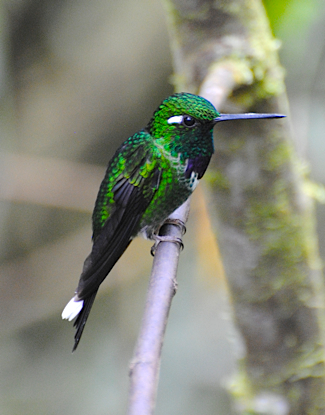
Like so many of
the other hummingbirds seen on this trip, the dainty
little Purple-bibbed Whitetip was a difficult bird to find
before the proliferation of feeders in many montane
regions of the country. (Photo by tour participants Bob
Sprague and Amy Levengood)
GREEN-CROWNED BRILLIANT (Heliodoxa jacula)
EMPRESS BRILLIANT
(Heliodoxa imperatrix)
VIOLET-FRONTED
BRILLIANT (Heliodoxa
leadbeateri)
GIANT HUMMINGBIRD
(Patagona gigas)
PURPLE-COLLARED
WOODSTAR (Myrtis fanny)
WHITE-BELLIED
WOODSTAR (Chaetocercus
mulsant)
LITTLE WOODSTAR
(Chaetocercus bombus)
PURPLE-THROATED
WOODSTAR (Calliphlox
mitchellii)
WESTERN EMERALD
(Chlorostilbon melanorhynchus)
BLUE-TAILED
EMERALD (Chlorostilbon
mellisugus)
VIOLET-HEADED
HUMMINGBIRD (Klais guimeti)
GREEN-CROWNED
WOODNYMPH (Thalurania fannyi)
FORK-TAILED
WOODNYMPH (Thalurania furcata)
AMAZILIA
HUMMINGBIRD (LOJA) (Amazilia
amazilia alticola)
ANDEAN EMERALD
(Amazilia franciae)
GLITTERING-THROATED
EMERALD (Amazilia fimbriata)
BLUE-CHESTED
HUMMINGBIRD (Amazilia
amabilis)
PURPLE-CHESTED
HUMMINGBIRD (Amazilia
rosenbergi)
RUFOUS-TAILED
HUMMINGBIRD (Amazilia tzacatl)
GOLDEN-TAILED
SAPPHIRE (Chrysuronia oenone)
VIOLET-BELLIED
HUMMINGBIRD (Damophila julie)
Trogonidae (Trogons)
GOLDEN-HEADED QUETZAL (Pharomachrus auriceps)
CRESTED QUETZAL
(Pharomachrus antisianus)
BLUE-TAILED TROGON
(Trogon comptus)
WHITE-TAILED
TROGON (Trogon chionurus)
COLLARED TROGON
(Trogon collaris)
MASKED TROGON
(Trogon personatus)
Momotidae (Motmots)
ANDEAN MOTMOT (Momotus aequatorialis aequatorialis)
RUFOUS MOTMOT
(Baryphthengus martii)
BROAD-BILLED
MOTMOT (BROAD-BILLED) (Electron
platyrhynchum platyrhynchum)
Alcedinidae (Kingfishers)
RINGED KINGFISHER (Megaceryle torquata)
AMAZON KINGFISHER
(Chloroceryle amazona)
GREEN KINGFISHER
(Chloroceryle americana)
Bucconidae (Puffbirds)
BARRED PUFFBIRD (Nystalus radiatus)
BLACK-STREAKED
PUFFBIRD (Malacoptila
fulvogularis)
LANCEOLATED
MONKLET (Micromonacha
lanceolata)
Galbulidae (Jacamars)
RUFOUS-TAILED JACAMAR (Galbula ruficauda)
COPPERY-CHESTED
JACAMAR (Galbula pastazae)
Capitonidae (New World Barbets)
ORANGE-FRONTED BARBET (Capito squamatus)
RED-HEADED BARBET
(Eubucco bourcierii)
Semnornithidae (Toucan-Barbets)
TOUCAN BARBET (Semnornis ramphastinus)
Ramphastidae (Toucans)
EMERALD TOUCANET (ANDEAN) (Aulacorhynchus prasinus albivitta)
CHESTNUT-TIPPED
TOUCANET (Aulacorhynchus
derbianus)
CRIMSON-RUMPED
TOUCANET (Aulacorhynchus
haematopygus)
GRAY-BREASTED
MOUNTAIN-TOUCAN (Andigena
hypoglauca)
PLATE-BILLED
MOUNTAIN-TOUCAN (Andigena
laminirostris)
COLLARED ARACARI
(STRIPE-BILLED) (Pteroglossus
torquatus erythropygius)
BLACK-MANDIBLED
TOUCAN (CHESTNUT-MANDIBLED) (Ramphastos
ambiguus swainsonii)
CHOCO TOUCAN
(Ramphastos brevis)
Picidae (Woodpeckers)
LAFRESNAYE'S PICULET (Picumnus lafresnayi)
OLIVACEOUS PICULET
(Picumnus olivaceus)
YELLOW-TUFTED
WOODPECKER (Melanerpes
cruentatus)
BLACK-CHEEKED
WOODPECKER (Melanerpes
pucherani)
SMOKY-BROWN
WOODPECKER (Picoides
fumigatus)
RED-RUMPED
WOODPECKER (Veniliornis
kirkii)
LITTLE WOODPECKER
(Veniliornis passerinus)
SCARLET-BACKED
WOODPECKER (Veniliornis
callonotus)
GOLDEN-OLIVE
WOODPECKER (Colaptes
rubiginosus)
CRIMSON-MANTLED
WOODPECKER (Colaptes rivolii)
CINNAMON
WOODPECKER (Celeus loricatus)
LINEATED
WOODPECKER (Dryocopus
lineatus)
POWERFUL
WOODPECKER (Campephilus
pollens)
Furnariidae (Ovenbirds and Woodcreepers)
STOUT-BILLED CINCLODES (Cinclodes excelsior)
CHESTNUT-WINGED
CINCLODES (Cinclodes
albidiventris albidiventris)
PALE-LEGGED
HORNERO (PACIFIC) (Furnarius
leucopus cinnamomeus)
ANDEAN
TIT-SPINETAIL (Leptasthenura
andicola)
AZARA'S SPINETAIL
(Synallaxis azarae)
DARK-BREASTED
SPINETAIL (Synallaxis
albigularis) [*]
RUFOUS SPINETAIL
(Synallaxis unirufa)
SLATY SPINETAIL
(Synallaxis brachyura) [*]
WHITE-BROWED
SPINETAIL (Hellmayrea gularis)
RED-FACED
SPINETAIL (Cranioleuca
erythrops)
ASH-BROWED
SPINETAIL (Cranioleuca
curtata)
LINE-CHEEKED
SPINETAIL (Cranioleuca
antisiensis)
MANY-STRIPED
CANASTERO (Asthenes
flammulata)
WHITE-CHINNED
THISTLETAIL (Asthenes
fuliginosa)
MOUSE-COLORED
THISTLETAIL (Asthenes
griseomurina)
EQUATORIAL
GRAYTAIL (Xenerpestes
singularis)
RUSTY-WINGED
BARBTAIL (Premnornis
guttuligera)
SPOTTED BARBTAIL
(Premnoplex brunnescens)
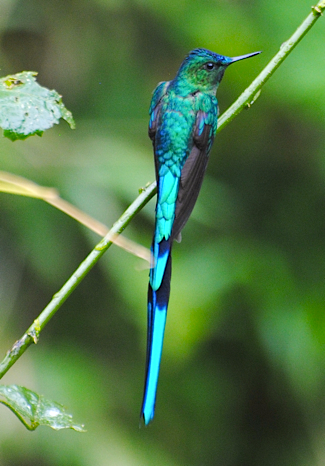
Long-tailed
Sylphs (like this male) are common on the east slope of
the Andes, much less so on the west slope, where they are
largely replaced by a sister species, Violet-tailed Sylph.
(Photo by tour participants Bob Sprague and Amy Levengood)
PEARLED TREERUNNER (Margarornis squamiger)
STREAKED
TUFTEDCHEEK (Pseudocolaptes
boissonneautii)
SCALY-THROATED
FOLIAGE-GLEANER (SPOT-BREASTED) (Anabacerthia variegaticeps temporalis)
MONTANE
FOLIAGE-GLEANER (Anabacerthia
striaticollis)
LINEATED
FOLIAGE-GLEANER (Syndactyla
subalaris) [*]
RUFOUS-NECKED
FOLIAGE-GLEANER (Syndactyla
ruficollis)
STRIPED
WOODHAUNTER (CENTRAL AMERICAN) (Hyloctistes
subulatus assimilis)
BUFF-FRONTED
FOLIAGE-GLEANER (Philydor
rufum)
UNIFORM TREEHUNTER
(Thripadectes ignobilis)
BLACK-BILLED
TREEHUNTER (Thripadectes
melanorhynchus) [*]
STREAK-CAPPED
TREEHUNTER (Thripadectes
virgaticeps)
RUDDY
FOLIAGE-GLEANER (Automolus
rubiginosus)
PLAIN XENOPS
(Xenops minutus)
STREAKED XENOPS
(Xenops rutilans)
TYRANNINE
WOODCREEPER (Dendrocincla
tyrannina)
PLAIN-BROWN
WOODCREEPER (Dendrocincla
fuliginosa)
OLIVACEOUS
WOODCREEPER (Sittasomus
griseicapillus)
WEDGE-BILLED
WOODCREEPER (Glyphorynchus
spirurus)
STRONG-BILLED
WOODCREEPER (Xiphocolaptes
promeropirhynchus)
BLACK-STRIPED
WOODCREEPER (Xiphorhynchus
lachrymosus)
SPOTTED
WOODCREEPER (Xiphorhynchus
erythropygius)
OLIVE-BACKED
WOODCREEPER (Xiphorhynchus
triangularis)
STREAK-HEADED
WOODCREEPER (Lepidocolaptes
souleyetii) [*]
MONTANE
WOODCREEPER (Lepidocolaptes
lacrymiger)
RED-BILLED
SCYTHEBILL (Campylorhamphus
trochilirostris)
Thamnophilidae (Typical Antbirds)
CHAPMAN'S ANTSHRIKE (Thamnophilus zarumae)
LINED ANTSHRIKE
(Thamnophilus tenuepunctatus) [*]
COLLARED ANTSHRIKE
(Thamnophilus bernardi)
WESTERN
SLATY-ANTSHRIKE (Thamnophilus
atrinucha) [*]
UNIFORM ANTSHRIKE
(Thamnophilus unicolor)
RUSSET ANTSHRIKE
(Thamnistes anabatinus)
CHECKER-THROATED
ANTWREN (Epinecrophylla
fulviventris)
MOUSTACHED ANTWREN
(MOUSTACHED) (Myrmotherula
ignota ignota)
PACIFIC ANTWREN
(Myrmotherula pacifica)
WHITE-FLANKED
ANTWREN (Myrmotherula
axillaris)
SLATY ANTWREN
(Myrmotherula schisticolor)
YELLOW-BREASTED
ANTWREN (Herpsilochmus
axillaris)
DOT-WINGED ANTWREN
(Microrhopias quixensis)
LONG-TAILED
ANTBIRD (Drymophila caudata)
RUFOUS-RUMPED
ANTWREN (Terenura callinota)
DUSKY ANTBIRD
(Cercomacra tyrannina) [*]
CHESTNUT-BACKED
ANTBIRD (Myrmeciza exsul)
[*]
IMMACULATE ANTBIRD
(Myrmeciza immaculata)
Formicariidae (Antthrushes)
BLACK-HEADED ANTTHRUSH (Formicarius nigricapillus) [*]
RUFOUS-BREASTED
ANTTHRUSH (Formicarius
rufipectus) [*]
BARRED ANTTHRUSH
(Chamaeza mollissima)
Grallariidae (Antpittas)
UNDULATED ANTPITTA (Grallaria squamigera) [*]
MOUSTACHED
ANTPITTA (Grallaria alleni)
[*]
SCALED ANTPITTA
(Grallaria guatimalensis) [*]
PLAIN-BACKED
ANTPITTA (Grallaria haplonota)
[*]
CHESTNUT-CROWNED
ANTPITTA (Grallaria
ruficapilla)
CHESTNUT-NAPED
ANTPITTA (Grallaria nuchalis)
[*]
YELLOW-BREASTED
ANTPITTA (Grallaria
flavotincta)
WHITE-BELLIED
ANTPITTA (Grallaria hypoleuca)
RUFOUS ANTPITTA
(Grallaria rufula)
TAWNY ANTPITTA
(Grallaria quitensis)
OCHRE-BREASTED
ANTPITTA (Grallaricula
flavirostris)
PERUVIAN ANTPITTA
(Grallaricula peruviana)
SLATE-CROWNED
ANTPITTA (Grallaricula nana)
CRESCENT-FACED
ANTPITTA (Grallaricula
lineifrons) [*]
Rhinocryptidae (Tapaculos)
OCELLATED TAPACULO (Acropternis orthonyx)
ASH-COLORED
TAPACULO (Myornis senilis)
BLACKISH TAPACULO
(BLACKISH) (Scytalopus latrans
latrans)
BLACKISH TAPACULO
(PACIFIC) (Scytalopus latrans
subcinereus) [*]
LONG-TAILED
TAPACULO (Scytalopus
micropterus) [*]
WHITE-CROWNED
TAPACULO (Scytalopus atratus
atratus) [*]
NARINO TAPACULO
(Scytalopus vicinior) [*]
SPILLMANN'S
TAPACULO (Scytalopus
spillmanni) [*]
CHUSQUEA TAPACULO
(Scytalopus parkeri)
Melanopareiidae (Crescentchests)
ELEGANT CRESCENTCHEST (Melanopareia elegans)
Tyrannidae (Tyrant Flycatchers)
BROWN-CAPPED TYRANNULET (Ornithion brunneicapillus)
SOUTHERN
BEARDLESS-TYRANNULET (Camptostoma
obsoletum)
WHITE-TAILED
TYRANNULET (Mecocerculus
poecilocercus)
WHITE-BANDED
TYRANNULET (Mecocerculus
stictopterus)
WHITE-THROATED
TYRANNULET (Mecocerculus
leucophrys)
SULPHUR-BELLIED
TYRANNULET (Mecocerculus
minor)
TUFTED TIT-TYRANT
(Anairetes parulus)
AGILE TIT-TYRANT
(Anairetes agilis)
MOUSE-COLORED
TYRANNULET (TUMBES) (Phaeomyias
murina tumbezana)
GRAY ELAENIA
(Myiopagis caniceps)
FOOTHILL ELAENIA
(Myiopagis olallai)
GREENISH ELAENIA
(Myiopagis viridicata) [*]
WHITE-CRESTED
ELAENIA (Elaenia albiceps)
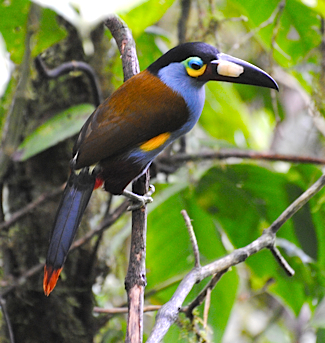
Three species of
mountain-toucan are possible on this tour; this is the
most range-restricted, and arguably the most handsome of
the trio- the Choco endemic Plate-billed Mountain-toucan.
(Photo by tour participants Bob Sprague and Amy Levengood)
MOTTLE-BACKED ELAENIA (Elaenia gigas)
SIERRAN ELAENIA
(Elaenia pallatangae)
TORRENT TYRANNULET
(Serpophaga cinerea)
STREAK-NECKED
FLYCATCHER (Mionectes
striaticollis)
OLIVE-STRIPED
FLYCATCHER (Mionectes
olivaceus)
OCHRE-BELLIED
FLYCATCHER (Mionectes
oleagineus)
SLATY-CAPPED
FLYCATCHER (Leptopogon
superciliaris)
RUFOUS-BREASTED
FLYCATCHER (Leptopogon
rufipectus)
VARIEGATED
BRISTLE-TYRANT (Phylloscartes
poecilotis)
MARBLE-FACED
BRISTLE-TYRANT (Phylloscartes
ophthalmicus)
ECUADORIAN
TYRANNULET (Phylloscartes
gualaquizae)
SOOTY-HEADED
TYRANNULET (Phyllomyias
griseiceps)
BLACK-CAPPED
TYRANNULET (Phyllomyias
nigrocapillus)
ASHY-HEADED
TYRANNULET (Phyllomyias
cinereiceps)
TAWNY-RUMPED
TYRANNULET (Phyllomyias
uropygialis) [*]
CHOCO TYRANNULET
(Zimmerius albigularis)
GOLDEN-FACED
TYRANNULET (Zimmerius
chrysops)
ORNATE FLYCATCHER
(Myiotriccus ornatus)
RUFOUS-HEADED
PYGMY-TYRANT (Pseudotriccus
ruficeps) [*]
TAWNY-CROWNED
PYGMY-TYRANT (Euscarthmus
meloryphus)
BLACK-CAPPED
PYGMY-TYRANT (Myiornis
atricapillus)
SCALE-CRESTED
PYGMY-TYRANT (Lophotriccus
pileatus)
RUFOUS-CROWNED
TODY-FLYCATCHER (Poecilotriccus
ruficeps)
COMMON
TODY-FLYCATCHER (Todirostrum
cinereum)
BLACK-HEADED
TODY-FLYCATCHER (Todirostrum
nigriceps)
YELLOW-OLIVE
FLYCATCHER (Tolmomyias
sulphurescens)
YELLOW-MARGINED
FLYCATCHER (YELLOW-MARGINED) (Tolmomyias
assimilis flavotectus)
GOLDEN-CROWNED
SPADEBILL (Platyrinchus
coronatus)
RUDDY-TAILED
FLYCATCHER (Terenotriccus
erythrurus)
CINNAMON
FLYCATCHER (Pyrrhomyias
cinnamomeus)
CLIFF FLYCATCHER
(Hirundinea ferruginea)
HANDSOME
FLYCATCHER (Nephelomyias
pulcher)
ORANGE-BANDED
FLYCATCHER (Nephelomyias
lintoni)
TAWNY-BREASTED
FLYCATCHER (Myiobius villosus)
SULPHUR-RUMPED
FLYCATCHER (Myiobius
sulphureipygius)
FLAVESCENT
FLYCATCHER (Myiophobus
flavicans)
ORANGE-CRESTED
FLYCATCHER (Myiophobus
phoenicomitra) [*]
OLIVE-CHESTED
FLYCATCHER (Myiophobus
cryptoxanthus)
BRAN-COLORED
FLYCATCHER (Myiophobus
fasciatus)
OLIVE-SIDED
FLYCATCHER (Contopus cooperi)
[b]
SMOKE-COLORED
PEWEE (Contopus fumigatus)
WESTERN WOOD-PEWEE
(Contopus sordidulus) [b]
ACADIAN FLYCATCHER
(Empidonax virescens) [b]
BLACK PHOEBE
(Sayornis nigricans)
VERMILION
FLYCATCHER (Pyrocephalus
rubinus)
PLAIN-CAPPED
GROUND-TYRANT (Muscisaxicola
alpinus)
BLACK-BILLED
SHRIKE-TYRANT (Agriornis
montanus)
WHITE-TAILED
SHRIKE-TYRANT (Agriornis
albicauda)
STREAK-THROATED
BUSH-TYRANT (Myiotheretes
striaticollis)
SMOKY BUSH-TYRANT
(Myiotheretes fumigatus) [*]
RED-RUMPED
BUSH-TYRANT (Cnemarchus
erythropygius)
MASKED
WATER-TYRANT (Fluvicola
nengeta)
CROWNED
CHAT-TYRANT (Ochthoeca
frontalis)
YELLOW-BELLIED
CHAT-TYRANT (Ochthoeca
diadema) [*]
SLATY-BACKED
CHAT-TYRANT (Ochthoeca
cinnamomeiventris)
RUFOUS-BREASTED
CHAT-TYRANT (Ochthoeca
rufipectoralis)
BROWN-BACKED
CHAT-TYRANT (Ochthoeca
fumicolor)
SHORT-TAILED FIELD
TYRANT (Muscigralla
brevicauda)
BRIGHT-RUMPED
ATTILA (Attila spadiceus)
[*]
DUSKY-CAPPED
FLYCATCHER (Myiarchus
tuberculifer nigriceps)
SHORT-CRESTED
FLYCATCHER (Myiarchus ferox)
PALE-EDGED
FLYCATCHER (Myiarchus
cephalotes)
BOAT-BILLED
FLYCATCHER (Megarynchus
pitangua)
RUSTY-MARGINED
FLYCATCHER (Myiozetetes
cayanensis)
SOCIAL FLYCATCHER
(Myiozetetes similis)
LEMON-BROWED
FLYCATCHER (Conopias
cinchoneti)
GOLDEN-CROWNED
FLYCATCHER (Myiodynastes
chrysocephalus)
PIRATIC FLYCATCHER
(Legatus leucophaius)
TROPICAL KINGBIRD
(Tyrannus melancholicus)
Cotingidae (Cotingas)
GREEN-AND-BLACK FRUITEATER (Pipreola riefferii)
BARRED FRUITEATER
(Pipreola arcuata)
ORANGE-BREASTED
FRUITEATER (Pipreola jucunda)
BLACK-CHESTED
FRUITEATER (Pipreola
lubomirskii)
SCALED FRUITEATER
(Ampelioides tschudii)
RED-CRESTED
COTINGA (Ampelion
rubrocristatus)
ANDEAN
COCK-OF-THE-ROCK (Rupicola
peruvianus sanguinolentus)
ANDEAN
COCK-OF-THE-ROCK (Rupicola
peruvianus aequatorialis)
PURPLE-THROATED
FRUITCROW (Querula purpurata)
DUSKY PIHA
(Lipaugus fuscocinereus)
Pipridae (Manakins)
GOLDEN-WINGED MANAKIN (Masius chrysopterus)
CLUB-WINGED
MANAKIN (Machaeropterus
deliciosus)
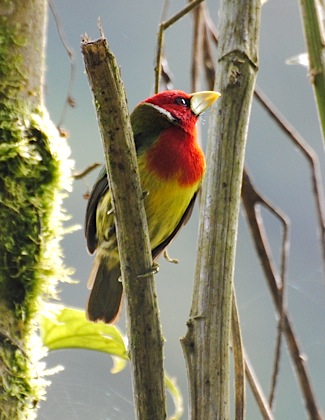
Though it's a
common and widespread species, the Red-headed Barbet is
still a stunning bird, and always a pleasure to see.
(Photo by tour participants Bob Sprague and Amy Levengood)
BLUE-RUMPED MANAKIN (Lepidothrix isidorei)
WHITE-BEARDED
MANAKIN (Manacus manacus)
Tityridae (Tityras and Allies)
MASKED TITYRA (Tityra semifasciata)
THRUSH-LIKE
SCHIFFORNIS (Schiffornis
turdina)
BARRED BECARD
(Pachyramphus versicolor)
CINNAMON BECARD
(Pachyramphus cinnamomeus)
WHITE-WINGED
BECARD (Pachyramphus
polychopterus dorsalis)
Vireonidae (Vireos)
BROWN-CAPPED VIREO (Vireo leucophrys)
OLIVACEOUS
GREENLET (Hylophilus
olivaceus)
LESSER GREENLET
(Hylophilus decurtatus)
SLATY-CAPPED
SHRIKE-VIREO (Vireolanius
leucotis)
RUFOUS-BROWED
PEPPERSHRIKE (Cyclarhis
gujanensis)
BLACK-BILLED
PEPPERSHRIKE (Cyclarhis
nigrirostris)
Corvidae (Crows, Jays, and Magpies)
BEAUTIFUL JAY (Cyanolyca pulchra)
TURQUOISE JAY
(Cyanolyca turcosa)
GREEN JAY (Cyanocorax yncas)
VIOLACEOUS JAY
(Cyanocorax violaceus) [*]
WHITE-TAILED JAY
(Cyanocorax mystacalis)
Hirundinidae (Swallows)
BLUE-AND-WHITE SWALLOW (Pygochelidon cyanoleuca)
PALE-FOOTED
SWALLOW (Orochelidon flavipes)
BROWN-BELLIED
SWALLOW (Orochelidon murina)
WHITE-THIGHED
SWALLOW (Atticora tibialis)
WHITE-BANDED
SWALLOW (Atticora fasciata)
SOUTHERN
ROUGH-WINGED SWALLOW (Stelgidopteryx
ruficollis)
GRAY-BREASTED
MARTIN (Progne chalybea)
Troglodytidae (Wrens)
FASCIATED WREN (Campylorhynchus fasciatus)
THRUSH-LIKE WREN
(Campylorhynchus turdinus)
GRAY-MANTLED WREN
(Odontorchilus branickii)
RUFOUS WREN
(Cinnycerthia unirufa)
SHARPE'S WREN
(Cinnycerthia olivascens)
PLAIN-TAILED WREN
(Pheugopedius euophrys)
CORAYA WREN
(Pheugopedius coraya) [*]
STRIPE-THROATED
WREN (Cantorchilus leucopogon)
BAY WREN (Cantorchilus nigricapillus)
SUPERCILIATED WREN
(Cantorchilus superciliaris)
HOUSE WREN
(Troglodytes aedon)
MOUNTAIN WREN
(Troglodytes solstitialis)
WHITE-BREASTED
WOOD-WREN (Henicorhina
leucosticta) [*]
GRAY-BREASTED
WOOD-WREN (Henicorhina
leucophrys)
SCALY-BREASTED
WREN (Microcerculus
marginatus) [*]
WING-BANDED WREN
(Microcerculus bambla) [*]
Polioptilidae (Gnatcatchers)
TAWNY-FACED GNATWREN (Microbates cinereiventris) [*]
TROPICAL
GNATCATCHER (WHITE-BROWED) (Polioptila
plumbea bilineata)
SLATE-THROATED
GNATCATCHER (Polioptila
schistaceigula)
Cinclidae (Dippers)
WHITE-CAPPED DIPPER (Cinclus leucocephalus)
Turdidae (Thrushes and Allies)
ANDEAN SOLITAIRE (Myadestes ralloides)
SPOTTED
NIGHTINGALE-THRUSH (Catharus
dryas) [*]
SWAINSON'S THRUSH
(Catharus ustulatus)
[b]
PALE-EYED THRUSH
(Turdus leucops)
PLUMBEOUS-BACKED
THRUSH (Turdus reevei)
PALE-VENTED THRUSH
(Turdus obsoletus)
ECUADORIAN THRUSH
(Turdus maculirostris)
BLACK-BILLED
THRUSH (Turdus ignobilis)
CHESTNUT-BELLIED
THRUSH (Turdus fulviventris)
SLATY THRUSH
(Turdus nigriceps)
GREAT THRUSH
(Turdus fuscater)
CHIGUANCO THRUSH
(Turdus chiguanco)
GLOSSY-BLACK
THRUSH (Turdus serranus)
WHITE-NECKED
THRUSH (Turdus albicollis)
Mimidae (Mockingbirds and Thrashers)
LONG-TAILED MOCKINGBIRD (Mimus longicaudatus)
Motacillidae (Wagtails and Pipits)
PARAMO PIPIT (Anthus bogotensis)
Parulidae (New World Warblers)
MOURNING WARBLER (Geothlypis philadelphia) [b]
OLIVE-CROWNED
YELLOWTHROAT (Geothlypis
semiflava)
CERULEAN WARBLER
(Setophaga cerulea) [b]
TROPICAL PARULA
(Setophaga pitiayumi)
BLACKBURNIAN
WARBLER (Setophaga fusca)
[b]
THREE-STRIPED
WARBLER (Basileuterus
tristriatus)
THREE-BANDED
WARBLER (Basileuterus
trifasciatus)
CITRINE WARBLER
(Myiothlypis luteoviridis)
BLACK-CRESTED
WARBLER (Myiothlypis
nigrocristatus)
BUFF-RUMPED
WARBLER (Myiothlypis
fulvicauda)
GOLDEN-BELLIED
WARBLER (CHOCO) (Myiothlypis
chrysogaster chlorophrys)
RUSSET-CROWNED
WARBLER (Myiothlypis
coronatus)
CANADA WARBLER
(Cardellina canadensis) [b]
SLATE-THROATED
REDSTART (Myioborus miniatus)
SPECTACLED
REDSTART (Myioborus
melanocephalus)
Coerebidae (Bananaquit)
BANANAQUIT (Coereba
flaveola)
Thraupidae (Tanagers and Allies)
MAGPIE TANAGER (Cissopis leverianus)
WHITE-CAPPED
TANAGER (Sericossypha
albocristata)
RUFOUS-CRESTED
TANAGER (Creurgops verticalis)
BLACK-CAPPED
HEMISPINGUS (Hemispingus
atropileus)
SUPERCILIARIED
HEMISPINGUS (Hemispingus
superciliaris)
BLACK-EARED
HEMISPINGUS (Hemispingus
melanotis)
BLACK-EARED
HEMISPINGUS (WESTERN) (Hemispingus
melanotis ochraceus)
BLACK-HEADED
HEMISPINGUS (Hemispingus
verticalis)
GRAY-HOODED BUSH
TANAGER (Cnemoscopus
rubrirostris)
CHESTNUT-VENTED
CONEBILL (Conirostrum
speciosum)
CINEREOUS CONEBILL
(Conirostrum cinereum)
BLUE-BACKED
CONEBILL (Conirostrum
sitticolor)
CAPPED CONEBILL
(Conirostrum albifrons atrocyaneum)
GIANT CONEBILL
(Oreomanes fraseri)
TIT-LIKE DACNIS
(Xenodacnis parina)
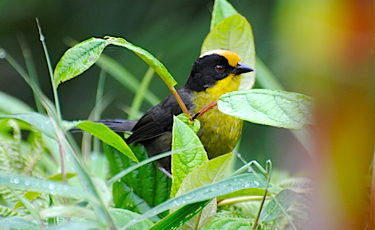
Brush-Finches are
at their most diverse in the Andes; this lovely Pale-naped
Brush-Finch at Guango was one of 7 species (in two genera)
seen. (Photo by tour participants Bob Sprague and Amy
Levengood)
PLUSHCAP (Catamblyrhynchus
diadema)
BLACK-BACKED BUSH
TANAGER (Urothraupis
stolzmanni)
GUIRA TANAGER
(Hemithraupis guira)
DUSKY-FACED
TANAGER (Mitrospingus
cassinii)
SCARLET-BROWED
TANAGER (Heterospingus
xanthopygius)
WHITE-SHOULDERED
TANAGER (Tachyphonus
luctuosus)
TAWNY-CRESTED
TANAGER (Tachyphonus delatrii)
WHITE-LINED
TANAGER (Tachyphonus rufus)
SILVER-BEAKED
TANAGER (Ramphocelus carbo)
FLAME-RUMPED
TANAGER (Ramphocelus
flammigerus)
BLUE-GRAY TANAGER
(Thraupis episcopus)
PALM TANAGER
(Thraupis palmarum)
BLUE-CAPPED
TANAGER (Thraupis
cyanocephala)
BLUE-AND-YELLOW
TANAGER (Thraupis bonariensis)
VERMILION TANAGER
(Calochaetes coccineus)
HOODED
MOUNTAIN-TANAGER (Buthraupis
montana)
BLACK-CHESTED
MOUNTAIN-TANAGER (Buthraupis
eximia)
LACRIMOSE
MOUNTAIN-TANAGER (Anisognathus
lacrymosus)
SCARLET-BELLIED
MOUNTAIN-TANAGER (Anisognathus
igniventris)
BLUE-WINGED
MOUNTAIN-TANAGER (Anisognathus
somptuosus)
BLACK-CHINNED
MOUNTAIN-TANAGER (Anisognathus
notabilis)
GRASS-GREEN
TANAGER (Chlorornis riefferii)
BUFF-BREASTED
MOUNTAIN-TANAGER (Dubusia
taeniata)
GOLDEN-CROWNED
TANAGER (Iridosornis
rufivertex)
FAWN-BREASTED
TANAGER (Pipraeidea
melanonota)
GLISTENING-GREEN
TANAGER (Chlorochrysa
phoenicotis)
ORANGE-EARED
TANAGER (Chlorochrysa
calliparaea)
GRAY-AND-GOLD
TANAGER (Tangara palmeri)
PARADISE TANAGER
(Tangara chilensis)
GREEN-AND-GOLD
TANAGER (Tangara schrankii)
GOLDEN TANAGER
(Tangara arthus)
SILVER-THROATED
TANAGER (Tangara
icterocephala)
SAFFRON-CROWNED
TANAGER (Tangara
xanthocephala)
GOLDEN-EARED
TANAGER (Tangara chrysotis)
FLAME-FACED
TANAGER (Tangara parzudakii
parzudakii)
FLAME-FACED
TANAGER (Tangara parzudakii
lunigera)
YELLOW-BELLIED
TANAGER (Tangara xanthogastra)
SPOTTED TANAGER
(Tangara punctata)
RUFOUS-THROATED
TANAGER (Tangara rufigula)
BAY-HEADED TANAGER
(Tangara gyrola)
RUFOUS-WINGED
TANAGER (Tangara lavinia)
SCRUB TANAGER
(Tangara vitriolina)
GOLDEN-NAPED
TANAGER (Tangara ruficervix)
METALLIC-GREEN
TANAGER (Tangara labradorides)
BLUE-BROWED
TANAGER (Tangara cyanotis)
BLUE-NECKED
TANAGER (Tangara cyanicollis)
GOLDEN-HOODED
TANAGER (Tangara larvata)
MASKED TANAGER
(Tangara nigrocincta)
BERYL-SPANGLED
TANAGER (Tangara nigroviridis)
BLUE-AND-BLACK
TANAGER (Tangara vassorii)
BLACK-CAPPED
TANAGER (Tangara heinei)
BLACK-FACED DACNIS
(BLACK-FACED) (Dacnis lineata
lineata)
BLACK-FACED DACNIS
(BLACK-FACED) (Dacnis lineata
aequatorialis)
YELLOW-BELLIED
DACNIS (Dacnis flaviventer)
SCARLET-THIGHED
DACNIS (Dacnis venusta)
BLUE DACNIS
(Dacnis cayana)
SCARLET-BREASTED
DACNIS (Dacnis berlepschi)
GREEN HONEYCREEPER
(Chlorophanes spiza)
PURPLE
HONEYCREEPER (Cyanerpes
caeruleus)
GOLDEN-COLLARED
HONEYCREEPER (Iridophanes
pulcherrimus)
SWALLOW TANAGER
(Tersina viridis)
GRAYISH SALTATOR
(Saltator coerulescens)
BLACK-COWLED
SALTATOR (Saltator nigriceps)
BUFF-THROATED
SALTATOR (Saltator maximus)
BLACK-WINGED
SALTATOR (Saltator atripennis)
SLATE-COLORED
GROSBEAK (Saltator grossus)
Emberizidae (Buntings, Sparrows and
Allies)
PLUMBEOUS SIERRA-FINCH (Phrygilus unicolor)
ASH-BREASTED
SIERRA-FINCH (Phrygilus
plebejus)
BAND-TAILED
SIERRA-FINCH (Phrygilus
alaudinus)
BLUE-BLACK
GRASSQUIT (Volatinia jacarina)
VARIABLE SEEDEATER
(Sporophila corvina ophthalmica)
YELLOW-BELLIED
SEEDEATER (Sporophila
nigricollis)
DRAB SEEDEATER
(Sporophila simplex)
CHESTNUT-BELLIED
SEEDEATER (Sporophila
castaneiventris)
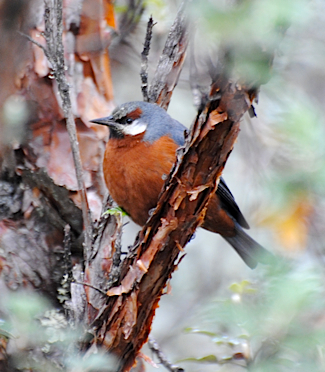
Though it's
pretty small for a "giant," the Giant Conebill, a
specialist of high elevation Polylepis forests, is always
a big target and a huge find! (Photo by tour participants
Bob Sprague and Amy Levengood)
CHESTNUT-THROATED SEEDEATER (Sporophila telasco)
THICK-BILLED
SEED-FINCH (Oryzoborus
funereus)
CHESTNUT-BELLIED
SEED-FINCH (Oryzoborus
angolensis)
BAND-TAILED
SEEDEATER (Catamenia analis)
PLAIN-COLORED
SEEDEATER (Catamenia inornata)
PARAMO SEEDEATER
(Catamenia homochroa)
DULL-COLORED
GRASSQUIT (Tiaris obscurus)
GLOSSY
FLOWERPIERCER (Diglossa
lafresnayii)
BLACK
FLOWERPIERCER (Diglossa
humeralis)
WHITE-SIDED
FLOWERPIERCER (Diglossa
albilatera)
RUSTY
FLOWERPIERCER (Diglossa
sittoides)
DEEP-BLUE
FLOWERPIERCER (Diglossa
glauca)
BLUISH
FLOWERPIERCER (Diglossa
caerulescens)
MASKED
FLOWERPIERCER (Diglossa
cyanea)
SAFFRON FINCH
(Sicalis flaveola)
GRASSLAND
YELLOW-FINCH (Sicalis luteola)
TANAGER FINCH
(Oreothraupis arremonops)
OLIVE FINCH
(Arremon castaneiceps)
CHESTNUT-CAPPED
BRUSH-FINCH (Arremon
brunneinucha)
ORANGE-BILLED
SPARROW (Arremon
aurantiirostris occidentalis)
[*]
ORANGE-BILLED
SPARROW (Arremon
aurantiirostris spectabilis)
GRAY-BROWED
BRUSH-FINCH (Arremon assimilis
assimilis)
BLACK-STRIPED
SPARROW (Arremonops
conirostris)
PALE-NAPED
BRUSH-FINCH (Atlapetes
pallidinucha)
TRICOLORED
BRUSH-FINCH (Atlapetes
tricolor)
YELLOW-BREASTED
BRUSH-FINCH (Atlapetes
latinuchus spodionotus)
YELLOW-BREASTED
BRUSH-FINCH (Atlapetes
latinuchus latinuchus)
SLATY BRUSH-FINCH
(Atlapetes schistaceus)
BAY-CROWNED
BRUSH-FINCH (Atlapetes
seebohmi)
TUMBES SPARROW
(Rhynchospiza stolzmanni)
YELLOW-BROWED
SPARROW (Ammodramus aurifrons)
[*]
RUFOUS-COLLARED
SPARROW (Zonotrichia capensis)
COMMON
BUSH-TANAGER (Chlorospingus
ophthalmicus)
DUSKY BUSH-TANAGER
(Chlorospingus semifuscus)
SHORT-BILLED
BUSH-TANAGER (Chlorospingus
parvirostris)
YELLOW-THROATED
BUSH-TANAGER (YELLOW-THROATED) (Chlorospingus
flavigularis marginatus)
YELLOW-THROATED
BUSH-TANAGER (YELLOW-THROATED) (Chlorospingus
flavigularis flavigularis)
ASHY-THROATED
BUSH-TANAGER (Chlorospingus
canigularis)
Cardinalidae (Cardinals and Allies)
SUMMER TANAGER (Piranga rubra) [b]
WHITE-WINGED
TANAGER (Piranga leucoptera)
RED-HOODED TANAGER
(Piranga rubriceps)
OCHRE-BREASTED
TANAGER (Chlorothraupis
stolzmanni)
GOLDEN-BELLIED
GROSBEAK (Pheucticus
chrysogaster)
BLUE-BLACK
GROSBEAK (Cyanocompsa
cyanoides)
Icteridae (Troupials and Allies)
PERUVIAN MEADOWLARK (Sturnella bellicosa)
SCRUB BLACKBIRD
(Dives warszewiczi)
SHINY COWBIRD
(Molothrus bonariensis)
YELLOW-TAILED
ORIOLE (Icterus mesomelas)
MOUNTAIN CACIQUE
(GOLDEN-SHOULDERED) (Cacicus
chrysonotus leucoramphus)
SCARLET-RUMPED
CACIQUE (PACIFIC) (Cacicus
uropygialis pacificus)
[*]
SCARLET-RUMPED
CACIQUE (SUBTROPICAL) (Cacicus
uropygialis uropygialis)
RUSSET-BACKED
OROPENDOLA (Psarocolius
angustifrons)
CRESTED OROPENDOLA
(Psarocolius decumanus)
Fringillidae (Siskins, Crossbills, and
Allies)
ORANGE-CROWNED EUPHONIA (Euphonia saturata)
THICK-BILLED
EUPHONIA (Euphonia
laniirostris)
GOLDEN-RUMPED
EUPHONIA (Euphonia
cyanocephala)
BRONZE-GREEN
EUPHONIA (Euphonia mesochrysa)
ORANGE-BELLIED
EUPHONIA (Euphonia
xanthogaster)
YELLOW-COLLARED
CHLOROPHONIA (Chlorophonia
flavirostris)
HOODED SISKIN
(Spinus magellanicus)
OLIVACEOUS SISKIN
(Spinus olivaceus)
BRAZILIAN RABBIT
(Sylvilagus brasiliensis)
RED-TAILED
SQUIRREL (Sciurus granatensis)
LONG-TAILED WEASEL
(Mustela frenata)
NEOTROPICAL OTTER
(Lontra longicaudis)
WHITE-TAILED DEER
(Odocoileus virginianus)
Totals for the tour: 616 bird taxa and 5 mammal taxa








